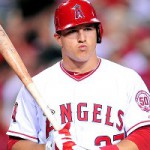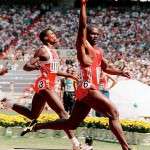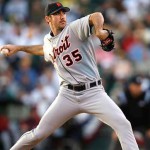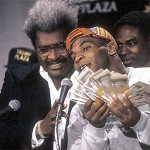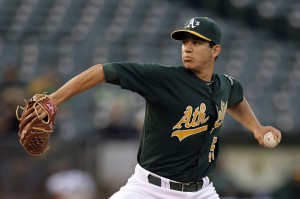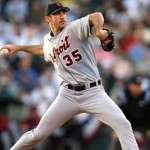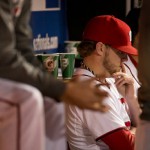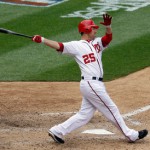
LaRoche's status with the team will dictate a number of cascading roster moves. Photo Rob Carr/Getty Images via bleacherreport.com
I havn’t seen mlb.com beat reporter Bill Ladson do an inbox response since February. So I was excited to see one pop in this past Monday, 10/22/12. As a reminder, I write my response before reading his, and sometimes edit questions for clarity.
Q: What are the Nationals’ plans for Tyler Moore? He is a power hitter who deserves to play every day. If Adam LaRoche returns next year, where does Moore fit in?
A: Tyler Moore indeed had excellent numbers in limited action, getting called up at the end of April to cover for a dearth of outfielders on the Nats roster. His slash line was .263/.327/.513 for an OPS+ of 124 with 10 homers in 156 Abs. Thats a homer ever 15.6 ABs and correlates to nearly a 40 homer pace for a full season of roughly 600 at-bats. That is of course if you believe in what we saw in 2012 versus the continued lack of respect for Moore from the scouting pundits (who think his minor league power numbers were more a function of age than talent, and who continued to think that Moore had too many holes in his swing to be an impact MLB player).
Unfortunately though for Moore, if Adam LaRoche is re-signed there may not be an immediate place for Moore in the lineup. LaRoche can only play 1B, Michael Morse is signed through 2013 and has become a club and fan favorite in LF. Those are basically the only two positions Moore can play.
I think the better question here is, “Will the Nats extend Adam LaRoche?” Because that’s the question that drives several other roster moves for 2013. If LaRoche comes back and the team favors giving Moore more playing time, maybe they package Morse in trade. Perhaps Moore sits and waits for another injury to give him playing time; LaRoche was incredibly healthy in 2012 and could regress for 2013. Or, perhaps LaRoche (as basically the leading 1B power hitter on the FA market) will get a 3-4 year deal (likely) and the Nats won’t over-pay for his decline years, will install Moore at first and keep Morse in left. Honestly, I think this last scenario is what plays out, and we’ll see Moore as your starting first baseman in 2013.
Ladson basically echos exactly what I say above. Glad we’re on the same page.
Q: Do you think the Nationals will go after Michael Bourn this offseason?
A: No no no! As I opined on September 13th, after seeing yet another Jim Bowden article intoning last off-season’s mantra of “the Nats need a center fielder,” the Nats HAVE a center fielder, and a darn good one, in Bryce Harper. Harper finished the season with the 4th best UZR/150 for any CF with 500+ innings, even better than the vaunted defensive wizard Mike Trout. It took about 5 games for his arm to be respected league wide, and he’s only 19 and will only get better. Why would we possible move Harper off CF in the next 4-5 years? Yes, eventually we expect a bulked up power hitting Harper to move to a corner spot, but not at age 20. Besides, if Harper moves off CF … who makes way in left or right? Do you move Jayson Werth to left field? If so, then what happens to Michael Morse? Do you move him? Harper’s defensive value is wasted in right field. Werth’s defensive value (while inarguably slipping) is also wasted in left field, where you can “hide” a poor defensive player who is plus-plus power.
*sigh* I wish this rumor would go away. I’m pretty sure the Yankees never said to Mickey Mantle at age 19, “Hey Mick! We like you in center but we to move you to a corner outfielder so we can sign a sub-average hitter to lead-off and play in your position.” Of course not, so why would the Nats do so?
Unfortunately Ladson perpetuates the ridiculous myth himself and says he thinks the team goes after Bourn and puts Harper in LF. Just ridiculous.
Q: Any news on Cole Kimball’s recovery? Will we see him in a Nats uniform in 2013?
A: Shoulder injuries in power pitchers are never an easy recovery. That’s why we never really saw Kimball in the summer and why he’s currently in the AFL getting some extra time on the hill. As of this writing he only has 3 2/3 innings, so not much to go by. We are seeing some reports that he looks decent. 2013 prognosis? He faces an uphill battle to make the bullpen; there’s several right handers that are now clearly ahead of him on the depth chart. Storen, Clippard, and Stammen are locks (if not traded). Rodriguez has no options. Mattheus has pitched his way onto this team. That’s your 5 righties out of the pen (Davey Johnson likes 2 lefties). And we havn’t even talked about Christain Garcia, who pitched well enough to make the post season roster. So the answer may be that Kimball starts in AAA and waits for an opportunity. Ladson says he thinks Kimball can make the 2013 bullpen. How exactly? Who is he going to be ahead of? Not much provided in the way of deep analysis, Bill.
Q: Do you think there is any chance the Nationals bring up Corey Brown to play center and bat second?
A: No. Brown looks to me like the definition of a 4-A guy, and will be stashed in AAA as outfield depth until further notice. Batting second? Really? We’re currently batting Werth at leadoff despite his having middle-of-the-order power. What makes anyone think Brown deserves to bat anywhere in this lineup, let alone ahead of the power guys? And, if Brown makes the 25-man roster which outfielder does he replace? Certainly not the starters in Morse, Harper and Werth. Certainly not Roger Bernadina, who more than earned his stay. And certainly not above Moore. Ladson agrees.
Q: What do you think about the addition of Kurt Suzuki to the roster?
A: Somewhat of a panic/reactionary move at the time, but it has worked out great for both sides. Jesus Flores wasn’t stopping the one-way street for opposing base-runners, and we needed more of a plus-defensive guy behind the plate. Flores did himself no favors batting .213 either. Suzuki immediately upped his batting stroke too, batting .267 here after hitting just .218 in Oakland in 2012. Clearly Suzuki and Wilson Ramos are your two catchers heading into 2013. What do we do with Flores? Do we dare non-tender him and give him away? Do we tender him and try to trade him? I’d hope for the latter, thinking that even a .213 hitting catcher has value in this league. I hate to say it, but Ramos can’t stay on the field and we needed the insurance. Ladson agrees, but doesn’t mention Flores’ fate.
Q: The Shark, aka Roger Bernadina, had a career year and will probably get a raise this offseason. Do you think the Nats are going to try to move him, or can we expect to see The Shark with the team next year?
A: Great question. Do we sell-high on Bernadina and make-do with a 4th outfielder like Corey Brown or Eury Perez in 2013? We could, if it brought us back something worth having. We do have some rising quality OF depth that would replace Bernadina (Brian Goodwin comes to mind, perhaps even Anthony Rendon if he hits his way to the majors in 2013). Ladson thinks Bernadina will be back. I have no problem with that; he hit great this year, knew his role and is fantastic defensively.
Q: Do you think Davey Johnson is the best manager in Nationals/Expos history? Felipe Alou is tough to beat, but Davey has my vote on this one.
A: Why not Jim Fanning? He led the franchise to its only prior post-season appearance. I dunno; what exactly makes a “good” manager? I think Johnson has absolutely done better with this team than anyone thought, so yeah that makes him a great manager (and my favorite for winning NL Manager of the Year). Best ever for the franchise? Why do people think Felipe Alou was so great? His last three Expos teams each lost 90 or more games. Who can really talk intelligently about how well Buck Rodgers mangaged the team in the mid 1980s? The team improved 19 wins from 1978 to 1979 under Dick Williams. Those are good managers too. Ladson thinks Johnson is the best ever but says Alou was great. I don’t get it.

